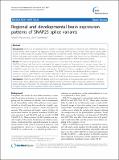Files in this item
Regional and developmental brain expression patterns of SNAP25 splice variants
Item metadata
| dc.contributor.author | Prescott, Gerald R. | |
| dc.contributor.author | Chamberlain, Luke H. | |
| dc.date.accessioned | 2014-01-20T14:31:01Z | |
| dc.date.available | 2014-01-20T14:31:01Z | |
| dc.date.issued | 2011-04-28 | |
| dc.identifier | 11733879 | |
| dc.identifier | f53b835e-8838-4027-850c-d8a188705449 | |
| dc.identifier | 000291154000001 | |
| dc.identifier | 79955135675 | |
| dc.identifier.citation | Prescott , G R & Chamberlain , L H 2011 , ' Regional and developmental brain expression patterns of SNAP25 splice variants ' , BioMed Central Neuroscience , vol. 12 , 35 . https://doi.org/10.1186/1471-2202-12-35 | en |
| dc.identifier.issn | 1471-2202 | |
| dc.identifier.uri | https://hdl.handle.net/10023/4406 | |
| dc.description | The authors’ laboratory is supported by a Medical Research Council senior fellowship award to LHC. | en |
| dc.description.abstract | Background: SNAP25 is an essential SNARE protein for regulated exocytosis in neuronal cells. Differential splicing of the SNAP25 gene results in the expression of two transcripts, SNAP25a and SNAP25b. These splice variants differ by only 9 amino acids, and studies of their expression to date have been limited to analysis of the corresponding mRNAs. Although these studies have been highly informative, it is possible that factors such as differential turnover of the SNAP25 proteins could complicate interpretations based entirely on mRNA expression profiles. Results: We report the generation and characterization of antibodies that distinguish between SNAP25a and SNAP25b isoforms, and their use to investigate the expression profile of these proteins in rat and human brain. In rat brain, SNAP25b protein expression increased dramatically during post-natal development, whereas the increase in SNAP25a expression was more modest and variable. The extent of this up-regulation in SNAP25b expression was similar across cortex, cerebellum and hippocampus. The SNAP25 isoforms also displayed distinct regional expression patterns, with SNAP25a very weakly expressed in both rat and human cerebellum. Quantitative analysis revealed that SNAP25b was the dominant isoform in all adult human brain regions examined. Conclusions: SNAP25a and SNAP25b display distinct developmental and regional expression profiles in rat and human brain. These differences might reflect distinct functions of these highly conserved isoforms in membrane fusion pathways in the brain. The antibodies generated and characterized in this study represent important tools for future analyses of these essential SNARE protein isoforms. | |
| dc.format.extent | 9 | |
| dc.format.extent | 831468 | |
| dc.language.iso | eng | |
| dc.relation.ispartof | BioMed Central Neuroscience | en |
| dc.subject | Differential expression | en |
| dc.subject | Protein snap-25 | en |
| dc.subject | Neurotransmitter release | en |
| dc.subject | Membrane fusion | en |
| dc.subject | Cell surface | en |
| dc.subject | PC12 cells | en |
| dc.subject | Isoforms | en |
| dc.subject | Palmitoylation | en |
| dc.subject | Neurotoxins | en |
| dc.title | Regional and developmental brain expression patterns of SNAP25 splice variants | en |
| dc.type | Journal article | en |
| dc.contributor.institution | University of St Andrews. School of Biology | en |
| dc.identifier.doi | https://doi.org/10.1186/1471-2202-12-35 | |
| dc.description.status | Peer reviewed | en |
This item appears in the following Collection(s)
Items in the St Andrews Research Repository are protected by copyright, with all rights reserved, unless otherwise indicated.

